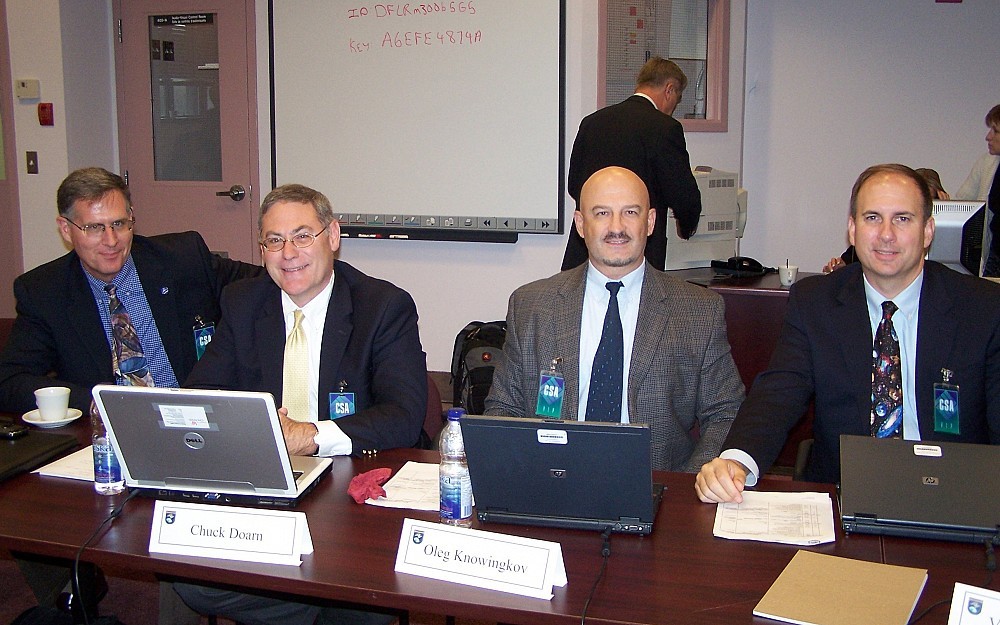
Focus on Research With Chuck Doarn
Focus On highlights faculty, staff, students and researchers at the UC Academic Health Center. To suggest someone to be featured, please email uchealthnews@uc.edu.
Charles Doarn, research professor in the department of public health sciences, always knew he wanted to be involved in medicine and public health. At Ohio State University, he studied biological sciences with a focus on microbiology, and after graduating in 1980, he spent several years as a chemist for the State of Ohio. He then became interested in environmental/inhalation toxicology at Battelle Memorial Institute in Columbus. This led to an opportunity to work in the Toxic Hazards Research Unit at Wright Patterson Air Force Base on studies for both the U.S. Navy and the U.S. Air Force on the inhaled toxicity of jet fuels and other chemicals. While working on his MBA at the University of Dayton, one of his classmates suggested a career path in Life Sciences Management. This classmates father owned a large company that had contracted for medical operations for human space flight at the NASA Johnson Space Center (JSC) in Houston. While at JSC and eventually at NASA headquarters in Washington, D.C., Doarns expertise in aerospace medicine and telemedicine grew in support of human space flight for the Space Shuttle Program and the International Space Station Program.
Doarn eventually reported directly to the chief medical officer of NASA, managing the aerospace functions and the development of medical policy. In addition, he wrote NASAs strategic plan for telemedicine. This led to the creation of a Commercial Space Center, initially developed at Yale University and eventually at the Medical College of Virginia in Richmond, which is where he worked with Timothy Broderick, MD, who is now in UCs department of surgery.
Doarn serves as the special assistant to the chief health and medical officer at NASA in Washington, D.C. He is also the editor of the Telemedicine and e-Health Journal.
What brought you to UC?
"While serving as executive director of NASAs Commercial Space Center on Medical Informatics and Technology Applications, the program director and chair of the department of surgery at MCV asked that my research group work with one of the general surgeons, Dr. Broderick. After several years of research activities, Dr. Broderick was recruited to come back home to UC. He conveyed strong support to then Surgery Chair Jeffrey Matthews that I would be an ideal person to lead the development of the Center for Surgical Innovation. Arriving in 2003 as a research associate professor and executive director, I helped build the center.
What is the focus of your research or the program that you lead?
"Since arriving at UC, I have been involved in a variety of research initiatives, including telemedicine, telesurgery, medicine in extreme environments and international and global health. This research has showcased UC as a leader in the development of surgical care using telecommunications and robotic surgical systems. Throughout out my entire career, I have looked at understanding and developing technologies and processes for bridging the gap in health care, including access.
"In the department of public health sciences I am in the process of developing a center for telemedicine at UC. Currently, I am writing three books related to my experiences with NASA. These books include Surgery in Extreme Environments, Space Medicine and Space Medicine Pioneers: In Their Own Words.
"I also serve as executive director of the non-profit International Virtual e-Hospital (IVeH). The IVeH has done work in the Balkans (Kosova and Albania), Amazon River and is developing telemedicine one country at a time.
How do you expect this research to impact patient care or the medical field in general?
"There is a growing shortage of physicians and allied health workers nationwide. Telemedicine and e-health are tools that can serve to increase access and impact health care and health care reform. These tools are powerful instruments of change and can impact health globally. The extreme nature of space flight lends itself to the development of new capabilities that have a direct impact in medical care and public health.
What are the next steps of your research?
"In the coming 5 to 10 years, health care capability for human missions to a near Earth asteroid and Mars will take shape. The development of the policies, requirements and technologies will provide fundamental changes in how we teach are students and how we treat our patients.
When youre not working, what do you do for fun?
"I enjoy writing and being an editor. Being the editor-in-chief of a journal has provided ample opportunity to write extensively. Writings include book chapters, federal government reports and manuscripts for peer-review. I enjoy my three children, my wife, and I love Ohio State football.

Charles Doarn
Tags
Related Stories
Yahoo News: Doctors see rising rates of colon cancer in younger...
May 1, 2024
Yahoo News featured comments from the University of Cincinnati's Rekha Chaudhary in a story about rising rates of diagnoses and deaths from colorectal cancers among young people.
Neuroimaging, AI help detect brain changes
May 1, 2024
Researchers at the University of Cincinnati and Dell Medical School at the University of Texas at Austin are leading a study using state-of-the-art neuroimaging techniques and artificial intelligence to identify changes in the brains among children of adults living with bipolar disorder.
From flight nurse aspirations to health care innovation: Meet...
April 30, 2024
We can thank flight nurses to Bachelor of Science in Nursing, Class of ’97 alumnus Nick Dobrzelecki’s interest in nursing. More than 30 years since making that decision, Dobrzelecki has not yet flown as a nurse, but has impacted the health care industry on many fronts.
